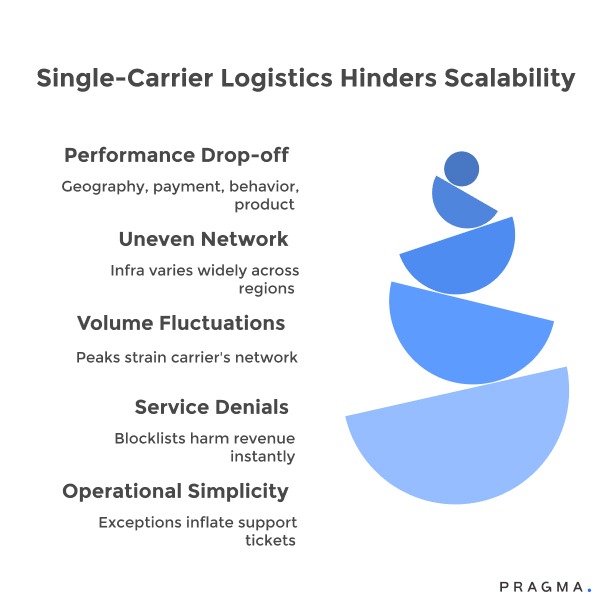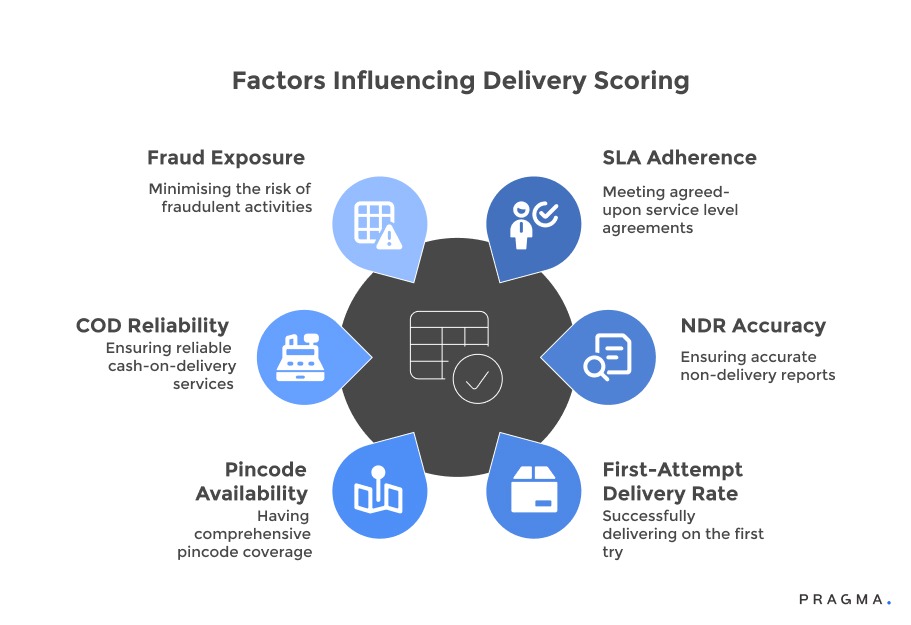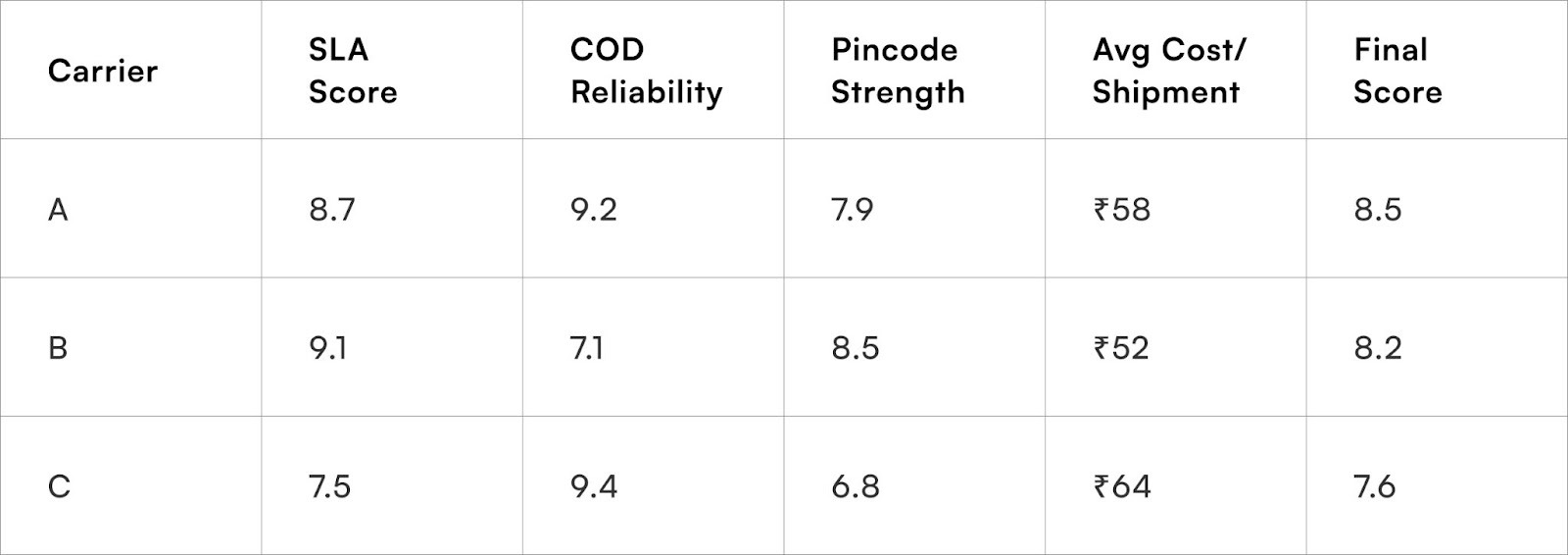Orders start strong through the morning, but your ops dashboard tells a different story by evening. Two pincodes show “service unavailable,” one partner suddenly marks 27 shipments as “RTO Recommended,” and a cash-heavy cluster delays pickups because the courier ran out of cash float.
Meanwhile, customers fire off support messages asking why delivery is taking five days when the promise was two. This tension escalates especially during season peaks, when one carrier silently deprioritises your loads in favour of enterprise clients.
Data from over 14,000 Indian D2C brands shows that single-carrier dependency increases RTO exposure by 19–32%, whilst SLA breaches rise when volume spikes beyond the carrier’s comfort zone. Carrier outages occur more often than founders expect — roughly 1.8 times per quarter — and each outage creates immediate revenue drag.
In this comprehensive guide on Multi-Carrier Management: When One Logistics Partner Isn’t Enough, we’re diving deep into how diversified routing, real-time allocation logic, and structured carrier performance governance help brands cut delays by 25% and reduce RTO losses by up to 18%. This approach transforms delivery reliability from a gamble into a measurable operational advantage.
Why does single-carrier dependency fail Indian D2C brands?
How one partner creates avoidable blind spots across delivery performance.

Single-carrier dependency feels simpler at first, but the gaps surface once orders scale beyond predictable patterns. You often see performance drop-off by geography, payment type, customer behaviour, and even product category.
These inconsistencies create unseen revenue leakage because the carrier optimises for its network economics, not your conversion or retention goals.
Indian logistics networks behave unevenly across Tier 2 and Tier 3 regions where infra varies widely. A carrier strong in metros may show 90% delivery success, yet the same partner may struggle below 58% in rural belts.
The critical insight is that no single logistics partner maintains consistent performance across India’s full pincode universe, and this inconsistency compounds when order volumes surge.
Carrier prioritisation adds another invisible constraint. During spikes, enterprise accounts absorb capacity, leaving mid-sized D2C brands with delayed pickups and extended line-haul cycles. Meanwhile, COD reconciliation delays increase disputes because slower partners hold cash for longer. These challenges force brands into reactive firefighting instead of predictable logistics planning.
Volume fluctuations reveal structural carrier weaknesses
Season peaks amplify weak zones in any carrier's network. Carriers allocate vehicles and labour dynamically, which means festive sales or influencer drops strain their local hubs. If you operate with a single partner, the moment that partner hits threshold, your orders join the backlog queue.
Service denials and abrupt blocklists harm revenue
If your only partner blocks lithium-ion products, oversized shipments, or selective COD routes, you lose orders instantly. Multi-carrier routing avoids such rigid constraints by offering alternatives for each special case.
Consider the operational simplicity of one API and one reconciliation cycle. It collapses, however, when exceptions inflate — delayed pickups, incorrect RTO tagging, slow hub movement. These symptoms dominate support tickets and frustrate customers who expect velocity. Multi-carrier setups counterbalance these weaknesses, ensuring continuity even when one partner underperforms.
How can multi-carrier routing improve delivery success rates?
Diversified routing distributes risk and aligns delivery promises with real network capacity.
Multi-carrier routing doesn’t simply add more couriers; it creates routing intelligence that matches each shipment with the partner best suited for that order’s attributes. Brands see dramatic improvements in
- COD conversions,
- NDR recovery, and
- SLA adherence
when they allow routing logic to work with real-world data instead of static preferences.The real advantage emerges through dynamic selection.
For example, a carrier might excel in Mumbai COD deliveries, whilst another performs better with prepaid orders in Kerala. Routing engines that learn from performance patterns redirect orders automatically, improving outcomes without manual intervention.
The most powerful shift occurs when routing moves from carrier-led to data-led decisioning, meaning your selection is no longer influenced by sales reps or anecdotal impressions but real, measurable delivery evidence.
Real-time routing adapts to daily performance variations
Carrier reliability can shift daily based on manpower, local traffic, or hub capacity. If your routing engine monitors live success trends, it adjusts allocation that same day.
Different SKUs demand different logistics strengths
Heavy items, fragile goods, and regulated products each require specific carrier competencies. Multi-carrier systems map carriers to SKU profiles, reducing risk of damage or returns.
The shift from single-carrier to multi-carrier resembles moving from manual stock-picking to warehouse automation — precision replaces guesswork, and consistency replaces hope.
What factors should influence carrier selection logic?
Routing improves when brands capture micro-level behavioural, geographical, and cost metrics.
Carrier selection is not a popularity contest; it’s an operational scoring system. When brands quantify carrier performance, routing decisions become objective and predictable. Multiple factors guide this scoring, including

- SLA adherence,
- NDR accuracy,
- First-attempt delivery rate,
- Pincode availability,
- COD reliability,
- And fraud exposure.
The challenge lies in combining these into a unified scoring model. Each carrier shines in some zones, struggles in others, and behaves differently for COD vs prepaid shipments. Creating multi-dimensional logic ensures each order meets the partner most suited to handle it.
Carrier Scoring Matrix Example

Scoring improves routing fairness and reduces bias
Operators often develop biases based on personal interactions with courier representatives. Scoring systems override this bias through data.
Route-by-route scoring prevents broad generalisation
Carriers rarely perform uniformly across India. Scoring should evaluate micro-routes, not broad city-level summaries.
By evaluating carriers across granular performance attributes, brands build routing models that consistently increase delivery success whilst reducing unnecessary shipping cost hikes.
How does multi-carrier management reduce RTO losses?
Diversification strengthens address accuracy, communication reliability, and NDR recovery.
RTO leakage often comes from three forces:
- Misattempts,
- Poor NDR follow-ups,
- And inaccurate customer-response handling.
Different carriers manage these differently. Some excel at same-day redelivery attempts, whilst others fail to communicate updates clearly.
Multi-carrier routing reduces RTO risk because orders go to partners who specialise in particular payment modes, risk zones, or behavioural clusters. COD-heavy regions often require carriers with trained delivery boys who know how to persuade customers effectively. Meanwhile prepaid shipments may need faster SLA-focused partners.
The strongest RTO reduction comes from matching customer behaviour clusters to the carriers best positioned to handle them, effectively turning delivery from reactive logistics into predictive interaction.
Address accuracy improves through carrier-level geocoding differences
Some carriers maintain superior mapping data for rural areas; routing to them increases first-attempt success.
NDR follow-ups depend heavily on the carrier’s tech maturity
Modern carriers support WhatsApp reattempts and instant rescheduling, whilst legacy ones rely on manual updates.
Through multi-carrier routing, brands avoid scenarios where a weak carrier mismanages NDR outcomes and triggers unnecessary RTO conversions.
What operational systems are required to manage multiple carriers?
Technology glues the ecosystem together whilst processes ensure discipline.
Multi-carrier management only works when supported by a structured operational backbone. Brands require unified tracking, automated allocation, SLA monitoring, performance dashboards, courier-wise billing reconciliation, and fraud detection.
While many founders fear that multi-carrier setups increase complexity, the opposite becomes true once automation kicks in. Instead of relying on one volatile partner, they gain predictable performance across the entire logistics chain.
Centralised dashboards provide unified visibility
A single pane for shipments, regardless of carrier, simplifies decision-making and reduces manual chaos.
Automated NDR systems sync customer decisions in real time
Brands avoid manual ticket updates by linking customer feedback directly to carrier reattempt requests.
Routing Decision Framework

This structured logic replaces guesswork with reliability and creates stable performance patterns.
How should Indian D2C brands govern multi-carrier relationships?
Governance ensures reliability, accountability, and continuous improvement.
Once your routing engine automates allocation, your carrier governance system ensures providers meet expectations. Without structured governance, multi-carrier setups drift into chaos, where carriers push blame onto each other and performance erodes.
The true power of multi-carrier ecosystems emerges when brands hold partners accountable through transparent, consistent performance governance, not emotional or reactive decision-making.
Monthly business reviews sharpen performance discipline
MBRs should include SLA analysis, issue deep-dives, and forward plans for volume spikes.
Contract structuring must protect your volume
Brands often miss clauses on guaranteed pickup commitments, COD remittance timelines, or penalties for SLA deviation.
Governance transforms multi-carrier routing from a flexible setup into a competitive advantage that drives predictable scale.
Quick Wins from Multi-Carrier Management
Week 1: Volume Mapping & SLA Baseline Setup
Start by analysing historical volume distribution across regions, SKUs, and payment modes. Capture SLA breaches for the last 45 days and identify the worst-performing pincodes. Create a baseline sheet combining cost, NDR accuracy, and first-attempt delivery rate. This week produces clarity on your current delivery fabric.
Week 2: Introduce Your Second Carrier
Onboard a secondary logistics partner focusing on your weakest routes or COD-heavy zones. Start by routing 20–25% of daily volume to this carrier. Track daily delivery consistency, pickup timing, and hub movement. Compare results against your Week 1 baseline.
Week 3: Enable Automated Allocation Rules
Implement basic logic such as “assign Carrier X for COD above ₹1,500” or “route heavy items >5kg to Carrier Y.” Monitor delivery improvements and NDR changes. Expand rule sets gradually.
Week 4: Conduct Your First Carrier Performance Review
Evaluate cost, SLA adherence, RTO rate, and customer communication quality. Re-adjust allocation splits accordingly. Document learnings and refine routing logic for next month.
TL;DR
Multi-carrier management reduces dependency, improves delivery reliability, and cuts RTO losses.
Brands that diversify see stronger SLA consistency and fewer operational shocks during spikes. Smart routing based on data, not preference, builds resilient fulfilment operations that scale smoothly.
To Wrap It Up
Multi-carrier management strengthens operational resilience by distributing risk, improving delivery speed, and reducing unnecessary RTO losses. Brands that diversify routing shift from reactive firefighting to predictable performance.
Take one action this week: onboard a second carrier and begin routing 20% of your orders through performance-based rules.
Long-term improvements emerge when brands refine routing, monitor SLAs, and govern partners consistently through structured performance reviews. Delivery excellence becomes systematic rather than accidental.
For D2C brands seeking smarter allocation, Pragma’s Multi-Carrier Routing Platform provides automated logic, carrier scoring, and unified dashboards that help brands reduce SLA breaches by up to 26%.

FAQs (Frequently Asked Questions On Multi-Carrier Management: When One Logistics Partner Isn’t Enough)
1. How many carriers should a D2C brand ideally work with?
Most brands perform best with two to four carriers, depending on volume and product categories.
2. Does multi-carrier management increase operational complexity?
It increases complexity initially, but automation dramatically simplifies it within weeks.
3. Which carrier works best for COD-heavy orders?
No single carrier wins everywhere; COD success varies by region and address cluster.
4. Can multi-carrier routing reduce RTO losses?
Yes — data-led allocation improves first-attempt delivery and reduces mismanaged NDR outcomes.
5. Should routing logic prioritise cost or SLA?
SLA should lead for high-value shipments, while cost optimisation suits low-risk prepaid or
Talk to our experts for a customised solution that can maximise your sales funnel
Book a demo



.webp)
.png)